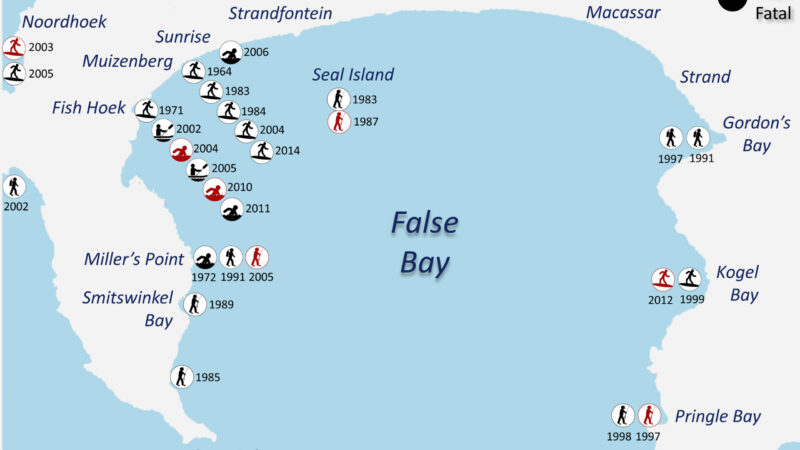
Tuesday
Jul 30, 2019 at 4:45 PM
Cue the annual shark-fueled fear fest with the return Sunday of the Discovery Channel’s widely celebrated Shark Week.
Now in its 31st year, the run of shark-themed programming has done as much to cultivate respect as it has scorn for the stealthy marine predator.
But despite the spectacle of scary footage and a spate of recent attacks, sharks pose less of a threat to humans than humans do to sharks, according to a slate of experts and a GateHouse Media analysis of the Global Shark Attack File.
Sharks have killed 40 people since 2014, based on data from the file, which is kept by the Shark Research Institute. The organization compiles information from a number of sources and actively investigates the incidents.
“Being killed by a piece of blue ice falling from a plane is a greater worry than being bit by a shark at the beach,” said Christopher Lowe, a professor and director of the California State University, Long Beach Shark Lab.
Humans, meanwhile, kill as many as millions of sharks annually. A well-cited 2013 study by researchers at Dalhousie University in Canada estimated more than 100 million are killed annually, though some experts dispute that number, saying it’s too high.
“We’re absolutely much more dangerous to them than they are to us,” said Lisa Natanson, a shark researcher for the National Oceanic and Atmospheric Administration.
“You can’t downplay that they’re a wild animal; they can kill you,” Natanson said. “But there’s over 500 species of sharks, and there’s less than 10 that would kill you. One person breaking the law and finning could slaughter hundreds of sharks.”
Finning is the practice of removing the shark’s fins — considered a culinary delicacy in some countries — and discarding its body. That, plus overfishing of the animals in general, has decimated the shark population worldwide, studies have shown.
Yet as their numbers dwindled, unprovoked shark-on-human attacks rose sharply over the years. In 1990, 34 such encounters were recorded in the database — three of them fatal. By 2015, that number climbed to 111; nine fatal.
Unprovoked attacks include those that occur when the victim wasn’t intentionally trying to interact with a shark as opposed to those in which the shark was being targeted by fishermen or thrill seekers.
Nearly 2,800 incidents were recorded in the database between 1990 and July of 2019. About 80 percent were unprovoked, according to the Global Shark Attack File.
“People should be concerned if there aren’t sharks in the water,” said Marie Levine, executive director of the Shark Research Institute and curator of the Global Shark Attack File. “Sharks are what keep the ocean healthy, and what keep the fish populations healthy.”
The organization took over the file in 1992, and the database goes back as far as 214 B.C., though data collection and reporting of incidents was sparse until recently.
More people, more bites
Researchers attributed the spike in incidents to an increase of people entering the oceans. Where once only a few people ventured, the ocean now attracts millions of swimmers, snorkelers and surfers each year.
“Humans now use the ocean for a wider variety of recreational activities than we ever did before,” Lowe said. “A lot of those activities have taken people farther offshore than they normally would, and that puts them in different environments where they’re going to encounter different species of sharks.”
Of the 2,195 incidents between 1990 and this year, nearly half took place in the United States — and more than 600 of them in Florida, a state almost entirely surrounded by salt water and which attracts some 125 million visitors each year.
One of those visitors was 11-year-old Iowa resident Kael Dewey, who got bit by a spinner shark while bodyboarding at Stuart Beach on Florida’s east coast in March. He suffered several wounds on his right foot requiring stitches but was otherwise OK.
Several additional incidents have taken place in the Sunshine State since then, including the July attack of 16-year-old Sarasota resident Jackie Jazaitis as she boogie boarded in the shallow surf on Amelia Island. The shark bit her ankle then let go. Jazaitis required eight stitches.
After Florida, the majority of unprovoked shark encounters occurred in Hawaii (157), California (105), South Carolina (79), North Carolina (66) and Texas (34).
Recent decline
But after an overall rise in shark-versus-human encounters, the numbers of such incidents dipped in 2016 and decreased even further in 2018.
Last year, 90 people had an unprovoked run-in with a shark — down from 111 such incidents in 2015. More than halfway through the current year, that number stands at 37.
For those few victims, though, the encounter can be deadly.
Twenty-one-year-old California college student Jordan Lindsey died in June after a trio of tiger sharks attacked her as she snorkeled in the Bahamas. The animals ripped off the woman’s right arm and gnawed at her legs.
Such high-profile fatalities negatively contribute to humans’ attitudes about sharks, even as the number of such incidents declines.
The downward trend aligns with data collected in another shark attack file maintained by the Florida Museum, although its numbers vary slightly.
Though researchers can’t pinpoint a definitive reason for the ebbing encounters, some suspect sharks’ diets play a role.
Like sharks themselves, the marine mammals they eat suffered a population decline in recent years. But experts say those species are on the rebound, meaning sharks are no longer curious about off-menu items, like humans.
“They’re less likely to try something that they don’t know what it is,” Lowe said. “They’re more likely to go after things they know.”
It could also be that people are learning how to be safe around sharks, or that climate change is redistributing sharks in places researchers haven’t seen them before.
“We just don’t really know,” Lowe said.
Be vigilant
Researchers also can’t say for sure why sharks attack people. But they do know most incidents don’t happen because sharks are preying on humans. Rather, they believe the sharks may bite because they’re confused, threatened or just curious.
“At the end of the day, for most incidents, we don’t really know why sharks occasionally, in unprovoked situations, bite people,” said Lowe, who studies shark behavior. “There are more people than ever before, and statistically your per-capita bite rate has been dramatically decreasing. That clearly tells me that sharks are not interested in people as a food source, but accidents happen.”
To avoid an accident, experts say, be vigilant.
Avoid swimming near dead animals, the smell of which can attract sharks from great distances.
And avoid “bait balls” — schools of fish that form and which could signal the presence of a nearby predator. Another potential sign of sharks: Seals or sea lions that attempt to crawl up on a surfboard or raft. They’re doing so not to be friendly, but to avoid being eaten, Lowe said. It’s a signal to get out of the water.
Nearly 800 people were surfing when they encountered a shark in an unprovoked incident between 1990 and 2018 according to the Global Shark Attack File.
Swimming, spearfishing and boogie boarding, body boarding or body surfing were also among the top activities when people encountered a shark.
Experts also say to swim in groups, and don’t splash around. Shark incidents are less likely to occur with more people around.
And avoid swimming at dusk and dawn, when sharks come out for feeding.
But it’s not just dusk and dawn, Natanson said.
“Sharks are in the water all the time,” Natanson said. “They’re not just in the water at dawn and dusk. You have to be vigilant all the time. You’re in their home.”





Recent Comments